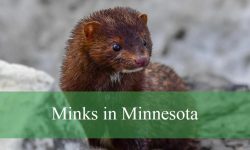Moths are fascinating creatures, often admired for their striking beauty and variety. Among the many colors they can display, pink and yellow moths stand out with their vibrant hues and delicate patterns. Whether you’re an entomologist or a nature enthusiast, discovering the beauty of these colorful moths can be both inspiring and educational.
In this article, we’ll explore 15 species of pink and yellow moths, showcasing their distinct features and providing you with images of these stunning creatures.
Common Pink and Yellow Moth Species
Small Elephant Hawkmoth
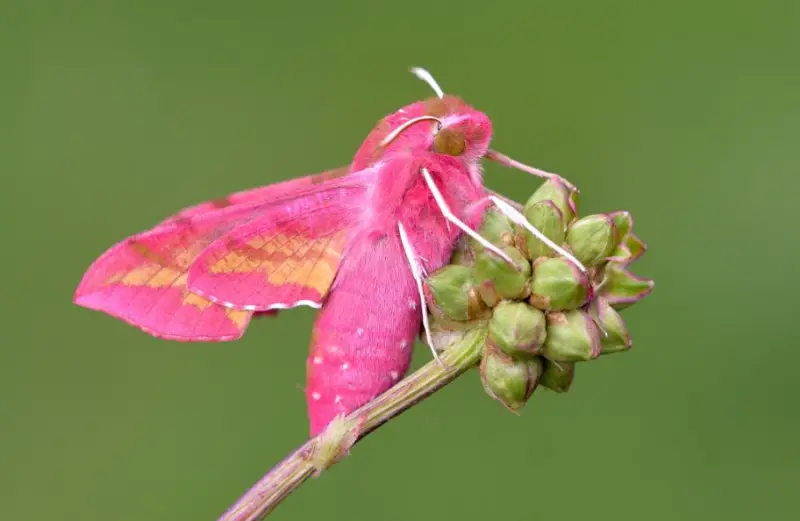
The Small Elephant Hawkmoth (Deilephila porcellus) is a stunning species native to Europe, Asia, and North Africa. It is known for its bold yellow and pink coloration, making it one of the most vibrant moths in its range.
The body of the moth is mostly covered in pink hairs, with small yellow sections appearing on the lower body. Its forewings have pink margins with a yellow inner section, while the hindwings follow a similar pattern, with pink edges and yellow centers.
In contrast to the colorful adult moth, the caterpillars of this species are dark gray or black, which helps them stay hidden from predators.
The Small Elephant Hawkmoth depends on wildflowers for survival, particularly bedstraw and other flowering plants. These moths are frequently seen in open meadows and grasslands, where they help pollinate local flora.
Clouded Buff
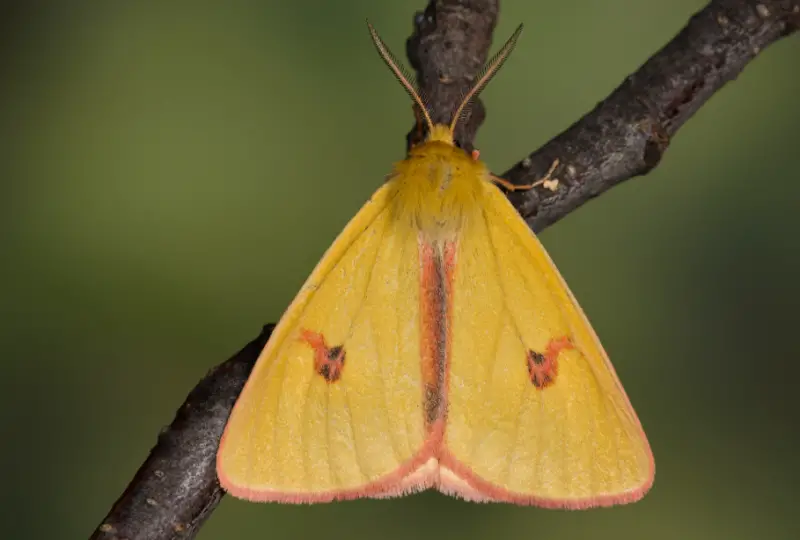
The Clouded Buff (Diacrisia sannio) is a striking moth species found across Europe, Asia, and North Africa. It is known for its yellow and pink coloration, particularly on its forewings and body.
Males are more brightly colored and active than females. They have yellow forewings with pink margins and pink markings, while their upper body and head display a golden yellow hue. The hindwings of males have a faded yellow and gray combination. Some individuals exhibit pink-dominant forewings, making them even more vibrant.
Clouded Buff moths are most active during the warmest months of summer. Unlike some other brightly colored moths, they are not native to North America but are widely distributed across Eurasia and North Africa.
Purple-barred Yellow
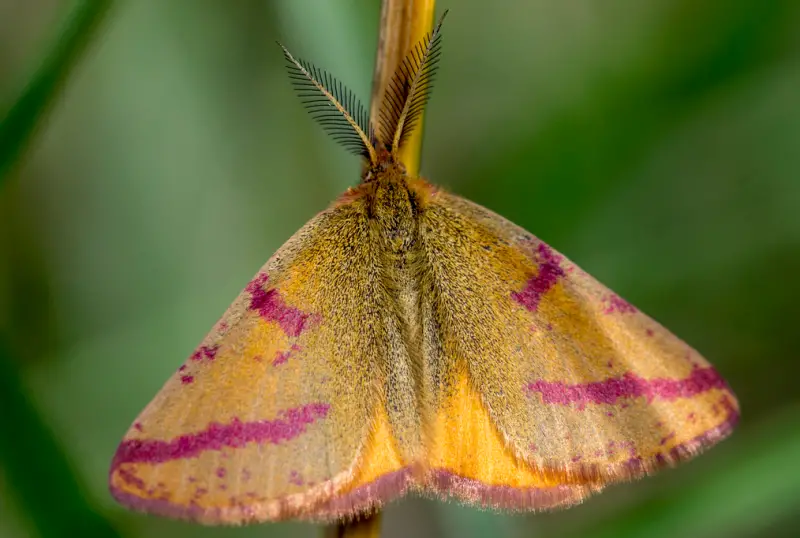
The Purple-barred Yellow (Lythria purpuraria) is a moth species known for its highly variable patterns of pink and yellow. The primary color of this species is yellow, but the intensity and arrangement of pink markings can differ between individuals.
The forewings often have pink bands or dots, with additional pink margins on both the forewings and hindwings. This variation in markings makes each moth look slightly different.
These moths are active in early and late summer, feeding on various wild plants, particularly knotweed. They are commonly found in Europe and Asia, where they thrive in open fields and meadows.
Western Sheep Moth
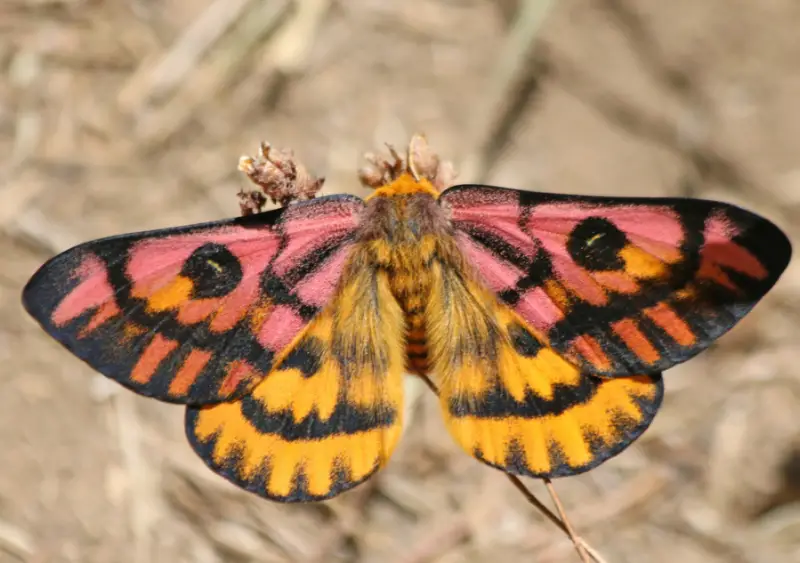
The Western Sheep Moth (Hemileuca eglanterina) is a large and visually stunning moth that comes in two primary color morphs: pink and yellow or yellow and black. A rare all-black morph also exists, though it is less commonly observed.
The forewings of this moth are pink with a yellow streak, while the hindwings are mostly yellow, creating a bright and distinctive pattern. This species is active mainly in early summer, particularly in western regions such as California.
The Western Sheep Moth is frequently seen visiting fragrant flowers and shrubs, including California lilac and various rose-family flowers. These plants serve as nectar sources and breeding grounds, as the moth lays cream-colored eggs directly on its host plants.
This species is primarily found in California and along the West Coast, where it contributes to pollination and biodiversity in local ecosystems.
Primrose Moth
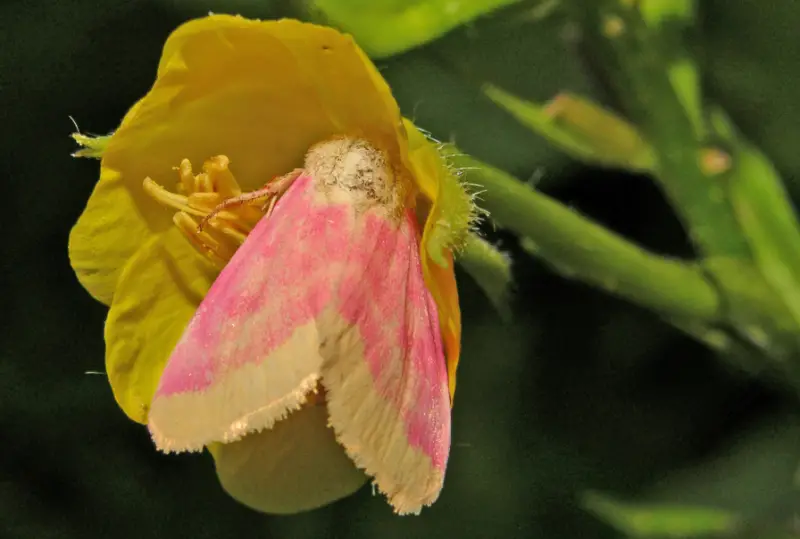
The Primrose Moth (Schinia florida) is a beautifully colored species commonly found in the Northeastern United States. It is closely associated with evening primrose flowers, where it lays its eggs and where its caterpillars feed.
This moth has a bright and striking appearance. Its hairy head and upper body are covered in bright yellow, while the lower body may appear yellow or even white. The wings are pale yellow or white, decorated with soft pink shades. Over time, these pink hues can darken, giving the moth an even more vibrant look.
Primrose Moths are typically seen until August in their northernmost range. By late summer, some individuals may develop deep pink forewings with white or yellow hindwings, making them easily recognizable.
Vestal
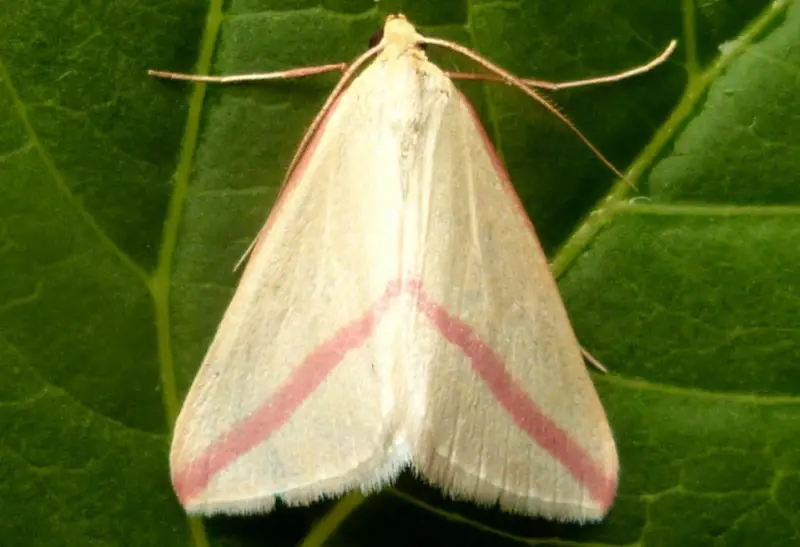
The Vestal (Rhodometra sacraria) is a delicate and elegant moth species found across Europe and Asia. It is known for its subtle yet striking coloration, with only pink and yellow visible when its wings are in a resting position.
The forewings are yellow, featuring a thin, bright pink band running diagonally across them. The hindwings are mostly white, while the moth’s head is also yellow. There are some variations in coloration between the sexes—males sometimes exhibit a more golden tone instead of yellow in certain regions.
The caterpillars of the Vestal Moth are also adapted for camouflage. They have a pink-red lateral band, and their body shape mimics twigs, helping them blend into their surroundings.
This species primarily feeds on dog fennel and knotgrass, which serve as its main host plants.
Elephant Hawkmoth
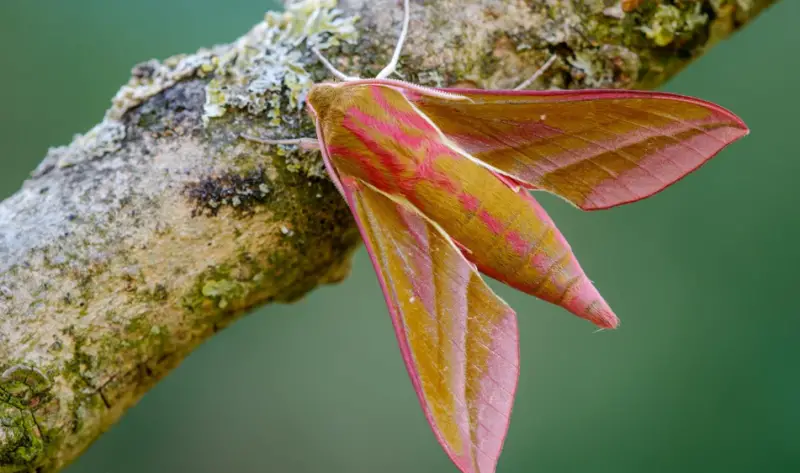
The Elephant Hawkmoth (Deilephila elpenor) is one of the most recognizable pink and yellow moths, found across Europe and North America. It is a large and colorful species, often mistaken for a hummingbird due to its ability to hover while feeding.
Its body, forewings, and hindwings feature a mustard-yellow base with pink contouring, creating a striking contrast. The ventral side of the moth is even more vibrant, with bright pink and yellow hues.
Elephant Hawkmoth caterpillars overwinter before emerging as adults in the warmer months. They are often attracted to artificial lights and can sometimes be found indoors.
This species primarily feeds on aromatic wildflowers, such as willowherb and bedstraw, making it an important pollinator in its ecosystem.
Inornate Pyrausta Moth
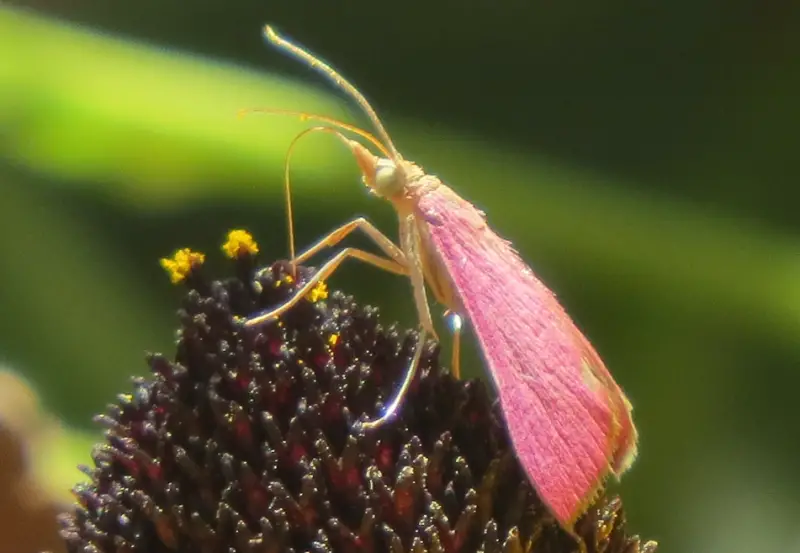
The Inornate Pyrausta Moth (Pyrausta inornatalis) is a small but vividly colored species native to the Southern United States and Mexico. It is known for its bright yellow body and hindwings, contrasting with its rose-pink forewings.
Some regional variations of this species display a vine-red coloration, making them even more distinct. These moths can be found resting in open habitats, where they often partially conceal their colorful wings.
Unlike many other moth species, the Inornate Pyrausta Moth is active almost year-round, thriving in warm climates from California to Florida. Its caterpillars primarily feed on plants in the sage family, such as mealy sage, contributing to the biodiversity of grasslands and open fields.
Rosy Maple Moth
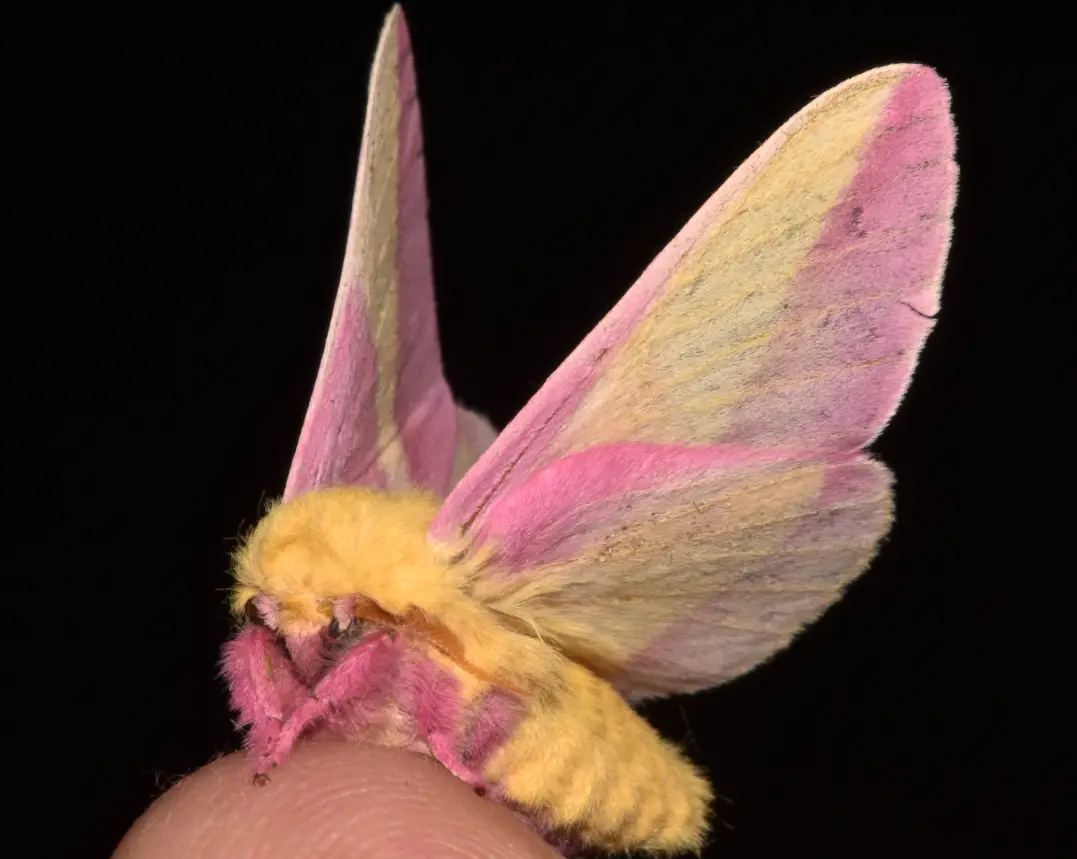
The Rosy Maple Moth (Dryocampa rubicunda) is a species of silk moth known for its vibrant yellow and pink coloration. It is one of the most visually striking moths in North America, commonly found in the Eastern United States and Southeastern Canada. This species thrives in forests, suburban areas, and even urban parks where maple and oak trees are abundant.
The adult Rosy Maple Moth has a compact, fuzzy body with bright yellow wings accented by pink bands. Its legs are also pink, often in a darker shade. The moth has a relatively small wingspan, typically ranging from 1.25 to 2 inches (3.2 to 5 cm). Despite its vivid appearance, it is primarily nocturnal, meaning it is most active at night.
In the caterpillar stage, this species is known as the Green-striped Mapleworm. The larvae primarily feed on the leaves of red maple, silver maple, and sugar maple trees. Once they mature into adults, they do not feed at all, as their primary purpose is reproduction.
Chickweed Geometer Moth
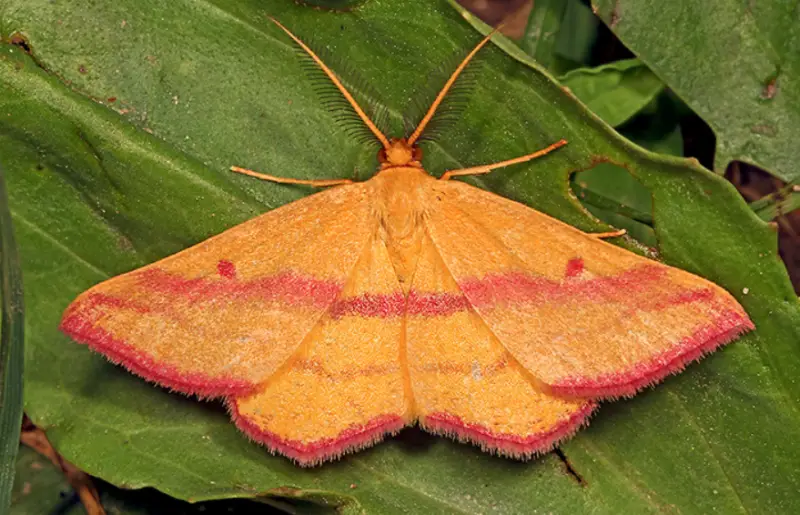
The Chickweed Geometer Moth (Haematopis grataria) is another eye-catching species found in the United States and Southern Canada. It is easily recognized by its pale yellow wings, which are decorated with thin pink bands along the edges and across the center. This delicate pattern helps distinguish it from other moth species.
One of the unique characteristics of this moth is its sexual dimorphism. While both males and females share the same yellow-pink coloration, males have feathery antennae, which they use to detect pheromones released by females. These moths are relatively small, with a wingspan of 0.75 to 1.25 inches (2 to 3 cm).
The caterpillars of the Chickweed Geometer Moth primarily feed on chickweed and other low-growing plants, making them common in gardens, meadows, and open fields. As adults, they become pollinators, visiting flowers at night while searching for mates. Their flight pattern is often described as “bouncing,” which helps them evade predators.
Mint-loving Pyrausta Moth
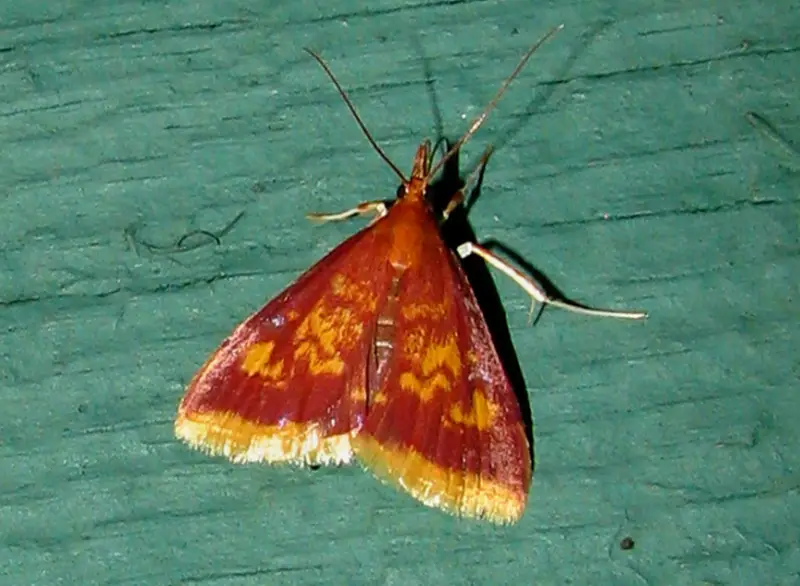
The Mint-loving Pyrausta Moth (Pyrausta acrionalis) is a small but striking species native to the Eastern and Southeastern United States. It gets its name from its preference for mint plants, which serve as the primary host for its larvae. These moths are often found in gardens, roadsides, and open fields where mint naturally grows.
This species is characterized by yellow forewings with pink or purplish patterns, which add to its distinct look. The hindwings are often a lighter shade of yellow, sometimes with a pinkish hue near the edges. The moth is relatively small, with a wingspan of around 0.5 to 1 inch (1.2 to 2.5 cm).
Unlike many moth species that prefer dense forests, the Mint-loving Pyrausta Moth is frequently spotted in suburban and urban areas, particularly where artificial lights attract them at night. Its attraction to light makes it a common sight near homes, especially during the warmer months.
As caterpillars, they feed on various mint species, including spearmint and peppermint. This diet gives them an advantage, as mint plants contain natural chemical compounds that help deter predators. Despite their small size, these moths play a vital role in pollination, ensuring the reproduction of many flowering plants.
Southern Purple Mint Moth
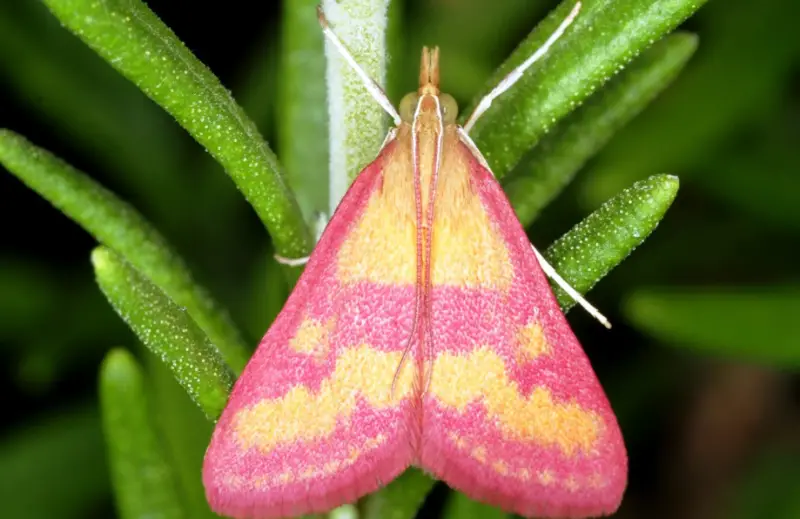
The Southern Purple Mint Moth (Pyrausta laticlavia) is a striking species recognized for its contrasting dark pink and yellow colors. Its wings are primarily yellow, featuring wide pink margins and pink bands that create a vivid pattern. This color combination helps it stand out among other moth species.
This moth is closely associated with rosemary, both as a food source and as a place to lay its eggs. When the larvae emerge, they display green and yellow coloration, allowing them to blend into the rosemary plant for camouflage. The species is capable of producing up to three broods per year, ensuring a continuous presence throughout the warmer months.
The Southern Purple Mint Moth is primarily found in the Southeastern United States and California, where rosemary grows abundantly.
Coffee-loving Pyrausta Moth
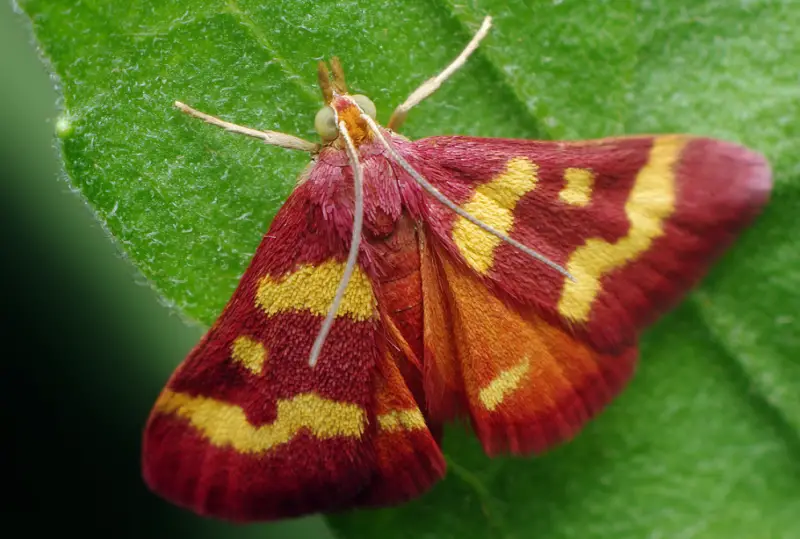
The Coffee-loving Pyrausta Moth (Pyrausta tyralis) is another visually striking moth species, recognized for its dark pink and yellow coloration. Its wings are mostly dark pink, accented with two interrupted yellow bands that provide contrast against the darker hues. Some specimens also have dark purple forewings with distinct yellow markings.
This species is named after its preferred host plants, which include wild coffee and clematis. It thrives in warm climates and remains active year-round in some regions of the United States, particularly in Mexico. Despite being primarily found in southern areas, it has occasionally been spotted as far north as New York.
The Coffee-loving Pyrausta Moth is distributed across the Eastern and Southern United States, Mexico, and Costa Rica, where it plays a role in local ecosystems as a pollinator.
Conclusion
Pink and yellow moths are some of the most visually captivating species in the moth world. Their vibrant colors and intricate patterns make them a joy to discover and observe in the wild. From the pale hues of the Rosy Maple Moth to the striking yellow and black patterns of the Yellow-Spotted Black Moth, these creatures add a burst of color to the night sky. If you’re lucky enough to encounter one of these stunning moths, you’ll be treated to a beautiful reminder of nature’s artistic abilities.



